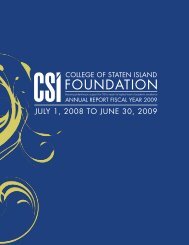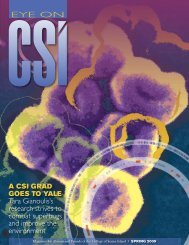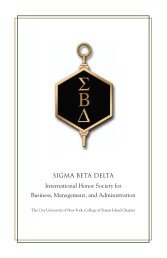csi undergraduate conference on research, scholarship ... - CSI Today
csi undergraduate conference on research, scholarship ... - CSI Today
csi undergraduate conference on research, scholarship ... - CSI Today
You also want an ePaper? Increase the reach of your titles
YUMPU automatically turns print PDFs into web optimized ePapers that Google loves.
Research Poster Presentati<strong>on</strong>sP O S T E R 4 5Asymmetric Allylati<strong>on</strong> of AldehydesCatalyzed by Optically ActiveSPINOL-Based Phosphoric AcidsYimei Zhang, M<strong>on</strong>ica Bassous,Chun-Hui XingFaculty Mentor: Dr. Qiao-Sheng HuDepartment of ChemistryThe asymmetric allyati<strong>on</strong> of allylbor<strong>on</strong>s withaldehydes c<strong>on</strong>stitutes <strong>on</strong>e of the most attractivemethods to access homoallylic alcohols. Transiti<strong>on</strong>metal-catalyzed such additi<strong>on</strong> reacti<strong>on</strong>s have beenpreviously reported. However, reported catalystsystems suffer from relative harsh reacti<strong>on</strong>c<strong>on</strong>diti<strong>on</strong>s and/or selectivity. We are interested indeveloping “green” catalysts, i.e., organocatalysts –the use of small organic compounds as chiralcatalysts, for such additi<strong>on</strong> reacti<strong>on</strong>s, especiallywith high enantioselectivities.1,1’-Spirodiindane-7,7’-diol (SPINOL) and itsderivatives have been dem<strong>on</strong>strated to be highlyenantioselective chiral scaffolds for a number ofuseful transformati<strong>on</strong>s. However, SPINOL-derivedBr<strong>on</strong>sted acids, which c<strong>on</strong>stitute a large family ofchiral organocatalysts, remain underexplored. Inthis presentati<strong>on</strong>, the use of spirodiindanediolbasedphosphoric acids as chiral catalysts forasymmetric allylati<strong>on</strong> of aldehydes willbe presented.P O S T E R 4 7Analysis of MIA-Induced Keratin-6Upregulati<strong>on</strong> in Mammary TissueSurendar RavindranFaculty Mentor: Dr. Jimmie FataDepartment of BiologyThe development of the mammary gland requiresco-ordinated tissue and cellular signals that directproper branching morphogenesis. Using threedimensi<strong>on</strong>al(3D) tissue cultures of mammary glanddevelopment we have previously found that a drugof the amiloride family, (N-Methyl, Nisobutyl)amiloride (MIA) drastically disrupts mammarydevelopment in this assay. MIA abrogates thefuncti<strong>on</strong> of the Na+/H exchanger type-1 (NHE-1),which is directly resp<strong>on</strong>sible for maintainingintracellular pH of mammary epithelial cells. Am<strong>on</strong>ga number of MIA-induced tissue and cellularphenotypes, we found that associated with thisinhibited morphogenesis was an increased andectopic expressi<strong>on</strong> of Keratin 6 (K6), anintermediate filament protein rarely expressed inmammary epithelial cells and <strong>on</strong>e that is involvedin hyper-proliferati<strong>on</strong>. To determine whether K6expressi<strong>on</strong> occured because of increasedtranscripti<strong>on</strong>al expressi<strong>on</strong>, I set out to measure K6mRNA levels in untreated and MIA-treatedmammary tissue using quantitative PCR. Theexperimental procedure of RT-PCR, the isolati<strong>on</strong> ofmRNA, and initial results are provided here al<strong>on</strong>gwith the technical hurdles we encountered.Determining whether MIA induces K6 upregulati<strong>on</strong>of transcripti<strong>on</strong> in mammary tissue may shed light<strong>on</strong> how co-ordinated signals become disruptedduring breast cancer.48
















